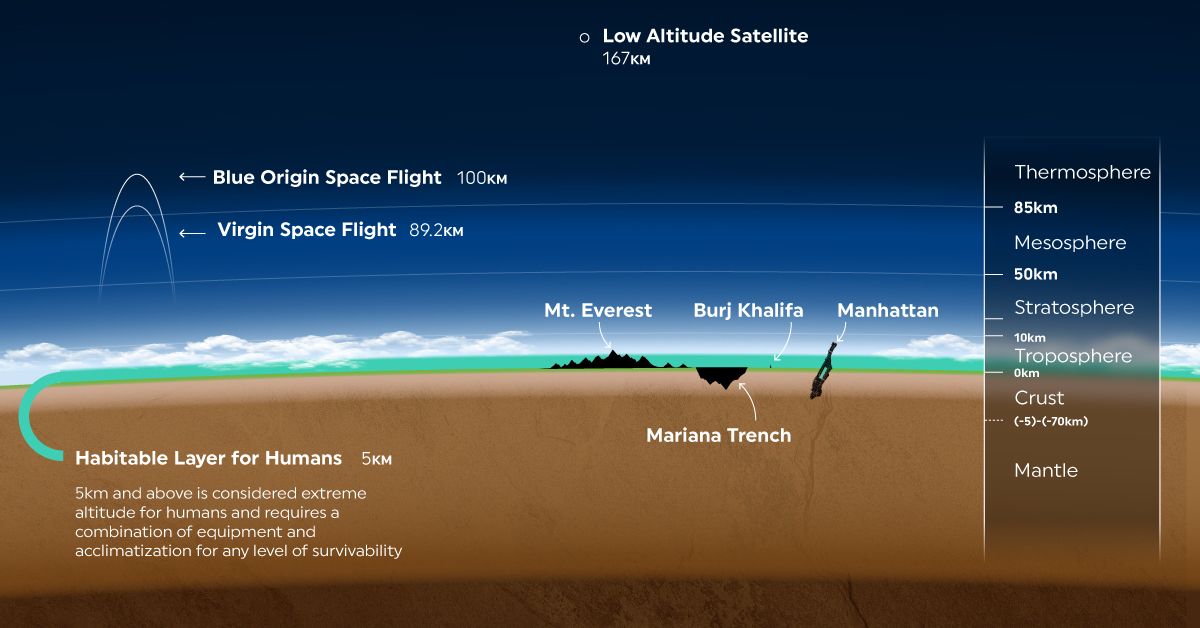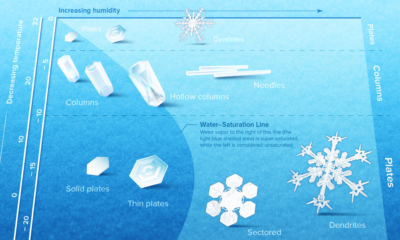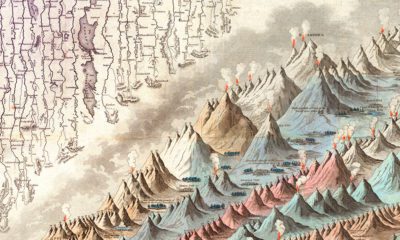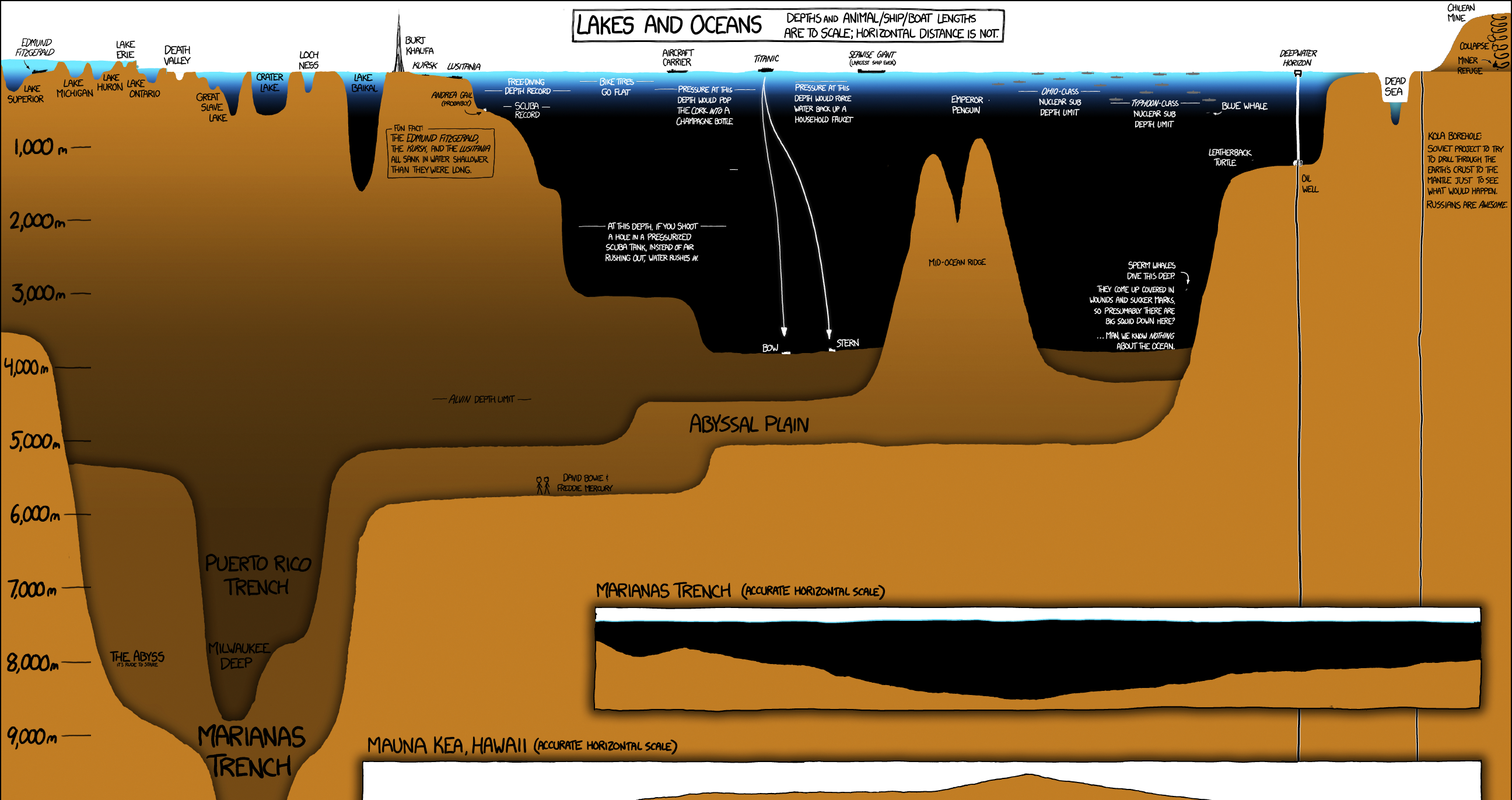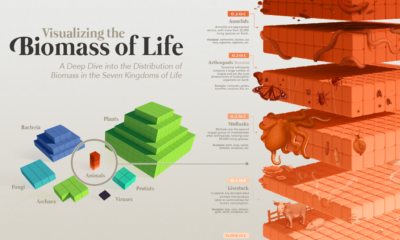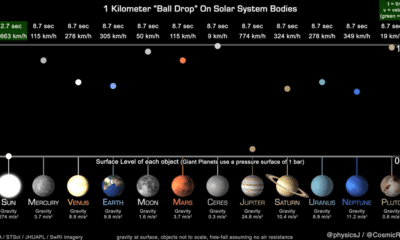Misc
Razor Thin: A New Perspective on Earth’s Atmosphere
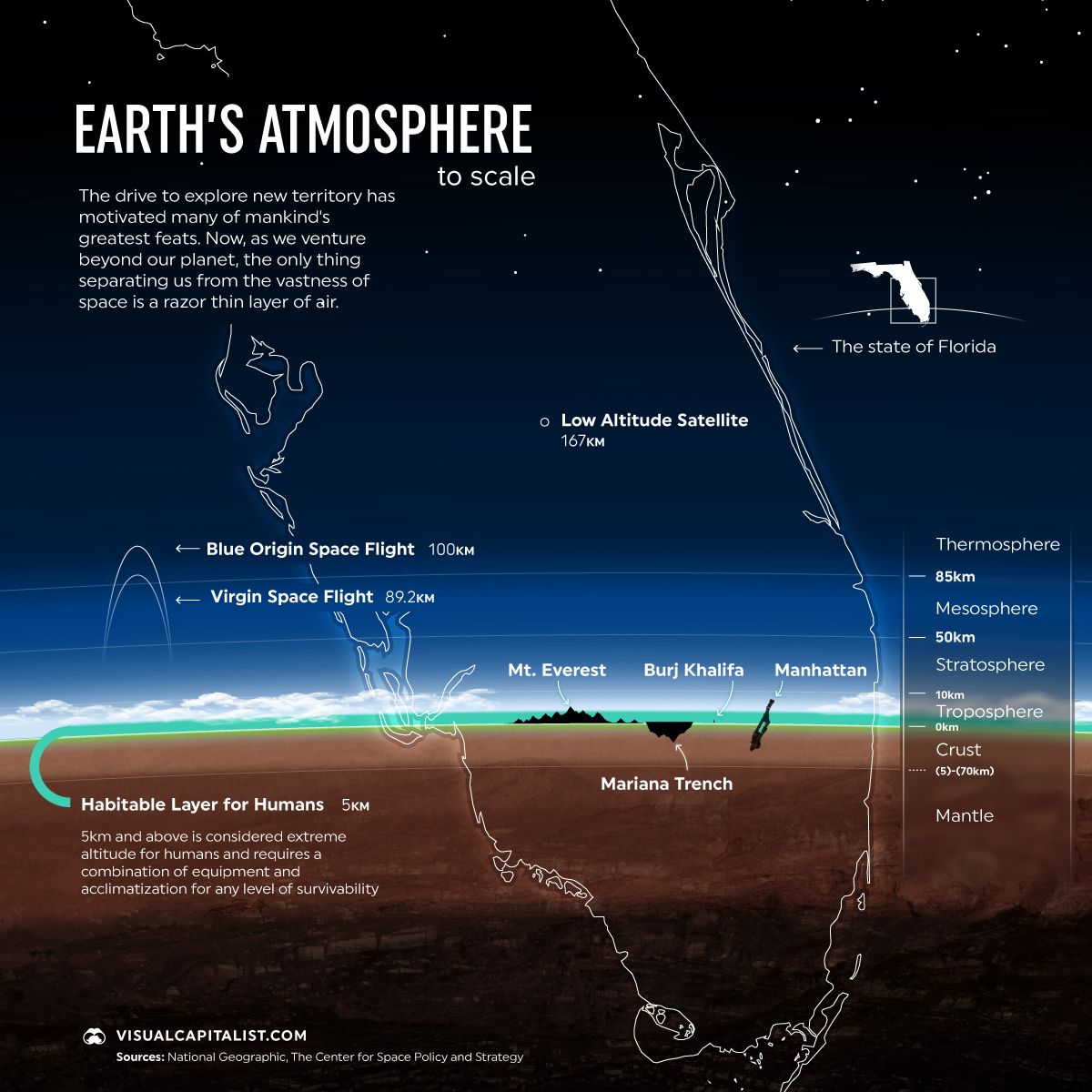
Razor Thin: A New Perspective on Earth’s Atmosphere
Earth is the only known planet that sustains life. Its atmosphere provides us with oxygen, protects us from the Sun’s radiation, and creates the barometric pressure needed so water stays liquid on our planet.
But while Earth’s atmosphere stretches for about 10,000 km (6,200 miles) above the planet’s surface, only a thin layer is actually habitable.
This graphic, inspired by Andrew Winter, shows just how small Earth’s “habitable zone” is, using the state of Florida as a point of reference.
Earth’s Like an Onion: It Has Layers
Our planet’s atmosphere is made up of a unique cocktail of gases—roughly 78% nitrogen and 21% oxygen, with trace amounts of water, argon, carbon dioxide, and other gases.
It’s separated into five different layers:
- Exosphere: The uppermost layer of our atmosphere that melds into outer space.
- Thermosphere: Begins at around 80 km (50 miles) above sea level and extends to approximately 600 km (372 miles), reaching temperatures as high as 2,000°C (3,600°F).
- Mesosphere: Around 30 km (19 miles) in range, meteors burn as they pass through this layer, creating “shooting stars.”
- Stratosphere: Home to the ozone layer, which is responsible for absorbing a majority of the sun’s radiation.
- Troposphere: The closest layer to ground. It stretches about 7–15 kilometers (5–10 miles) from the surface.
The troposphere makes up approximately 75-80% of the atmosphere’s mass, as it’s where most of the dust, ash, and water vapor are stored. But only a part of this layer is suitable for human life—in fact, the atmosphere’s habitable zone is so small, several mountain ranges extend beyond it.
Reaching Into Earth’s Atmosphere: Extremely High Altitudes
Elevations above 5,500 meters (18,000 ft) are considered extremely high altitude and require special equipment and/or acclimatization in order to survive. Even then, those who choose to venture to extreme heights run the risk of getting altitude sickness.
When it comes to the world’s tallest mountain ranges, the Himalayas are the highest. At their peak, Mount Everest, the Himalayas reach 8,848 m (29,000 ft) above sea level.
| Mountain range | Highest mountain | Height | Countries |
|---|---|---|---|
| Himalayas | Mount Everest | 8,848 m | Nepal, China |
| Karakoram | K2 | 8,611 m | Pakistan |
| Hindu Kush | Tirich Mir | 7,708 m | Pakistan |
| Kongur Shan | Kongur Tagh | 7,649 m | China |
| Daxue Mountains | Mount Gongga | 7,556 m | China |
| Pamir Mountains | Ismoil Somoni Peak | 7,495 m | Tajikistan |
| Kakshaal Too | Jengish Chokusu | 7,439 m | China, Kyrgyzstan |
| Nyenchen Tanglha Mountains | Gyala Peri | 7,294 m | China |
| Andes | Aconcagua | 6,960 m | Argentina |
| Kunlun Mountains | Chakragil | 6,760 m | China |
| Cordillera de la Ramada | Mercedario | 6,720 m | Argentina |
| Tian Shan | Xuelian Feng | 6,627 m | China |
| Hindu Raj | Buni Zom | 6,542 m | Pakistan |
| Cordillera Occidental | Chimborazo | 6,263 m | Ecuador |
| Alaska Range | Denali | 6,191 m | USA |
| Saint Elias Mountains | Mount Logan | 5,959 m | Canada |
| Eastern Rift mountains | Mount Kilimanjaro | 5,895 m | Tanzania |
| Sierra Nevada de Santa Marta | Pico Cristóbal Colón | 5,700 m | Colombia |
| Caucasus Mountains | Mount Elbrus | 5,642 m | Russia |
| Trans-Mexican Volcanic Belt | Pico de Orizaba | 5,636 m | Mexico |
| Alborz | Mount Damavand | 5,610 m | Iran |
| Yun Range | Jade Dragon Snow Mountain | 5,596 m | China |
| Bogda Shan | Bogda Peak | 5,445 m | China |
| Cordillera Oriental | Ritacuba Blanco | 5,410 m | Colombia |
| Armenian Highlands | Mount Ararat | 5,137 m | Turkey |
| Rwenzori Mountains | Mount Stanley | 5,109 m | Congo, Uganda |
Despite the dangers of extreme altitude, hundreds of mountaineers attempt to climb Mount Everest each year. On Everest, the region above 8,000 m (26,000 feet) is referred to as the “death zone,” and climbers have to bring bottled oxygen on their trek in order to survive.
Life Beyond Earth
Earth is the only known planet with an atmosphere we can survive in. And even on Earth, certain areas are considered dead zones.
But there may be other life forms out in the galaxy that we haven’t discovered. Recent research in The Astrophysical Journal predicts there are at least 36 intelligent civilizations throughout the galaxy today.
So life may very well exist beyond Earth. It just might look a bit different than we’re used to.
Maps
Mapped: The 10 U.S. States With the Lowest Real GDP Growth
In this graphic, we show where real GDP lagged the most across America in 2023 as high interest rates weighed on state economies.

The Top 10 U.S. States, by Lowest Real GDP Growth
This was originally posted on our Voronoi app. Download the app for free on iOS or Android and discover incredible data-driven charts from a variety of trusted sources.
While the U.S. economy defied expectations in 2023, posting 2.5% in real GDP growth, several states lagged behind.
Last year, oil-producing states led the pack in terms of real GDP growth across America, while the lowest growth was seen in states that were more sensitive to the impact of high interest rates, particularly due to slowdowns in the manufacturing and finance sectors.
This graphic shows the 10 states with the least robust real GDP growth in 2023, based on data from the Bureau of Economic Analysis.
Weakest State Economies in 2023
Below, we show the states with the slowest economic activity in inflation-adjusted terms, using chained 2017 dollars:
| Rank | State | Real GDP Growth 2023 YoY | Real GDP 2023 |
|---|---|---|---|
| 1 | Delaware | -1.2% | $74B |
| 2 | Wisconsin | +0.2% | $337B |
| 3 | New York | +0.7% | $1.8T |
| 4 | Missississippi | +0.7% | $115B |
| 5 | Georgia | +0.8% | $661B |
| 6 | Minnesota | +1.2% | $384B |
| 7 | New Hampshire | +1.2% | $91B |
| 8 | Ohio | +1.2% | $698B |
| 9 | Iowa | +1.3% | $200B |
| 10 | Illinois | +1.3% | $876B |
| U.S. | +2.5% | $22.4T |
Delaware witnessed the slowest growth in the country, with real GDP growth of -1.2% over the year as a sluggish finance and insurance sector dampened the state’s economy.
Like Delaware, the Midwestern state of Wisconsin also experienced declines across the finance and insurance sector, in addition to steep drops in the agriculture and manufacturing industries.
America’s third-biggest economy, New York, grew just 0.7% in 2023, falling far below the U.S. average. High interest rates took a toll on key sectors, with notable slowdowns in the construction and manufacturing sectors. In addition, falling home prices and a weaker job market contributed to slower economic growth.
Meanwhile, Georgia experienced the fifth-lowest real GDP growth rate. In March 2024, Rivian paused plans to build a $5 billion EV factory in Georgia, which was set to be one of the biggest economic development initiatives in the state in history.
These delays are likely to exacerbate setbacks for the state, however, both Kia and Hyundai have made significant investments in the EV industry, which could help boost Georgia’s manufacturing sector looking ahead.
-

 Technology1 week ago
Technology1 week agoCountries With the Highest Rates of Crypto Ownership
-

 Mining6 days ago
Mining6 days agoVisualizing Copper Production by Country in 2023
-

 Politics7 days ago
Politics7 days agoCharted: How Americans Feel About Federal Government Agencies
-

 Healthcare1 week ago
Healthcare1 week agoWhich Countries Have the Highest Infant Mortality Rates?
-

 Demographics1 week ago
Demographics1 week agoMapped: U.S. Immigrants by Region
-

 Economy1 week ago
Economy1 week agoMapped: Southeast Asia’s GDP Per Capita, by Country
-

 Automotive1 week ago
Automotive1 week agoHow People Get Around in America, Europe, and Asia
-

 Personal Finance1 week ago
Personal Finance1 week agoVisualizing the Tax Burden of Every U.S. State




